
| 纯度 | >90%SDS-PAGE. |
| 种属 | Human |
| 靶点 | N4BP2 |
| Uniprot No | Q86UW6 |
| 内毒素 | < 0.01EU/μg |
| 表达宿主 | E.coli |
| 表达区间 | 1671-1770 aa |
| 活性数据 | HLAAIEIFEKVNASLLPQNVLDLHGLHVDEALEHLMRVLEKKTEEFKQNGGKPYLSVITGRGNHSQGGVARIKPAVIKYLISHSFRFSEIKPGCLKVMLK |
| 分子量 | 36.74 kDa |
| 蛋白标签 | GST-tag at N-terminal |
| 缓冲液 | 0 |
| 稳定性 & 储存条件 | Lyophilized protein should be stored at ≤ -20°C, stable for one year after receipt. Reconstituted protein solution can be stored at 2-8°C for 2-7 days. Aliquots of reconstituted samples are stable at ≤ -20°C for 3 months. |
| 复溶 | Always centrifuge tubes before opening.Do not mix by vortex or pipetting. It is not recommended to reconstitute to a concentration less than 100μg/ml. Dissolve the lyophilized protein in distilled water. Please aliquot the reconstituted solution to minimize freeze-thaw cycles. |
以下是关于重组人N4BP2蛋白的假设性参考文献示例(注:实际文献需通过学术数据库验证):
1. **文献名称**:*"Recombinant N4BP2 modulates ubiquitin-dependent signaling in vitro"*
**作者**:Smith J. et al. (2021)
**摘要**:研究报道了重组人N4BP2蛋白在泛素化通路中的调控作用,通过体外实验证明其与E3泛素连接酶NEDD4的相互作用,影响底物蛋白的降解过程。
2. **文献名称**:*"High-yield expression and crystal structure determination of human N4BP2 in E. coli"*
**作者**:Zhang L. et al. (2019)
**摘要**:成功在大肠杆菌中表达并纯化可溶性重组N4BP2蛋白,优化条件后获得高分辨率晶体结构,为功能研究奠定基础。
3. **文献名称**:*"N4BP2 inhibits NF-κB activation via TRAF6 ubiquitination"*
**作者**:Chen R. et al. (2022)
**摘要**:通过重组N4BP2过表达实验,发现其通过介导TRAF6的泛素化修饰抑制NF-κB信号通路,下调炎症反应。
4. **文献名称**:*"N4BP2 as a novel regulator of neuronal development"*
**作者**:Garcia M. et al. (2020)
**摘要**:研究利用重组N4BP2蛋白体外处理神经元,发现其促进突触生长,提示其在神经发育中的潜在作用。
**建议**:实际研究中,可通过PubMed或Google Scholar使用关键词“N4BP2 recombinant”或“N4BP2 protein”检索最新文献,并核实蛋白别名(如NEDD4BP2)可能存在的差异。
N4BP2 (NEDD4-binding protein 2), also known as natural killer cell-enriched antigen (NKEA4), is a multidomain protein encoded by the human *N4BP2* gene. It interacts with the E3 ubiquitin ligase NEDD4 and regulates protein ubiquitination, a critical post-translational modification involved in diverse cellular processes. Structurally, N4BP2 contains a conserved N-terminal pseudokinase domain, a central coiled-coil region, and a C-terminal PRD (proline-rich domain), facilitating protein-protein interactions and signaling modulation. Functionally, it plays roles in innate immunity, inflammation, and neuronal development. Studies suggest its involvement in suppressing excessive immune responses by targeting cytokines or immune receptors for degradation via the ubiquitin-proteasome system. In neurobiology, N4BP2 may influence axon guidance and synapse formation. Recombinant human N4BP2 protein, typically produced in bacterial or mammalian expression systems, retains these functional domains and is utilized to study its biochemical interactions, structural features, and therapeutic potential. Current research focuses on its regulatory mechanisms in viral defense pathways (e.g., RIG-I signaling), inflammatory diseases, and cancer progression. Its dual role in immune regulation and neural function positions N4BP2 as a promising target for treating autoimmune disorders, infections, or neurodegenerative conditions.
×